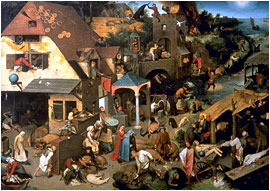Proverbs were well-known to the people of 16th-century Flanders. For example, a contemporary of Bruegel, Frans Hogenberg, produced an engraving around 1558 illustrating some 40 proverbs.
According to the Columbia Encyclopedia, a proverb is a short statement of wisdom or advice that has passed into general use. More homely than aphorisms, proverbs generally refer to common experience and are often expressed in metaphor, alliteration, or rhyme, e.g., “A bird in the hand is worth two in the bush,” “When the cat’s away, the mice will play.” Proverbs abound in the Bible, in early Greek and Roman literature, and in the gnomic verse of the Anglo-Saxons. In medieval literature proverbs serve in homilies and exempla to drive home moral lessons and, as in the works of Chaucer, to add a humorous note. To the traditional folk sayings the Renaissance writers added the more literary proverbs from the classics; the most famous collection was Adagia by Erasmus (1500). Proverbs were extremely popular among the Elizabethans, the most famous collections being those of John Heywood (1549?) and Florio (1578). Although the popularity of proverbs declined in the 18th century, they have become a subject for research and classification in more modern times. There is a famous collection by William Hazlitt (1869). Noted 20th-century compilations include The Book of Proverbs (1965), ed. by Paul Rosenzweig, and The Oxford Dictionary of English Proverbs (1970), ed. by W. G. Smith and F. P. Wilson. (The Columbia Encyclopedia, Sixth Edition, 2001)
In this program, a selection of proverbs is identified to provide you with a starting point to a better understanding of Bruegel’s painting. The identification of the proverbs in Bruegel’s painting is based on Gustav Gluck, Peter Brueghel the Elder, New York, 1936; Walter Gibson, Bruegel, London, 1977; Mark A. Meadow, Pieter Bruegel the Elder’s Netherlandish Proverbs and the Practice of Rhetoric, Zwolle, 2002.
 |
 |
 Pieter Bruegel the Elder, The Netherlandish Proverbs or The Blue Cloak, (panel; 117 x 163 cm [46 X 64 1/8 in.]), Staatliche Museen, Berlin, Signed and dated bottom right: BRVEGEL 1559 |
|
